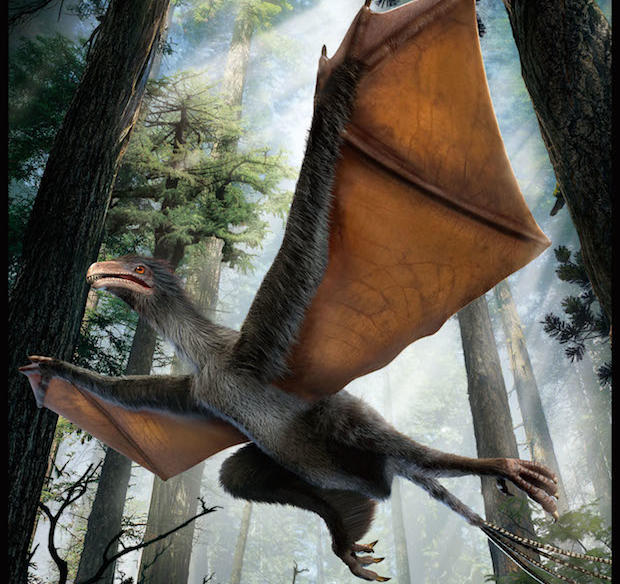Dinosaur fossil with bat wings is first of its kind
A bat-like dinosaur has been unearthed in China that had wings made of skin rather than feathers, showing there may have been different ways of flying before the emergence of birds.
The tiny dinosaur discovered by a local farmer from Jurassic rocks in northeast China has been named Yi qi, which means "strange wing" in Mandarin. It belongs to a group of dinosaurs with long hands called scansoriopterygids that thrived 160 million years ago and so far are known only to be from China. Scansoriopterygids are closely related to small, primitive birds such as the Archaeopteryx, but there was previously no evidence that they could take to the air.
"It highlights how complex the transition from dinosaur to birds is," said Xu Xing of the Institute of Vertebrate Paleontology, and Paleoanthropology (IVPP) in Beijing, who along with Zheng Xiaoting of Linyi University and several others described the finding in the journal Nature on Wednesday.
"Yi qi lived in the Jurassic, so it was a pioneer in the evolution of flight on the line to birds," Zheng added. "It reminds us that the early history of flight was full of innovations, not all of which survived."
Initially, Xu and his colleagues assumed their new, pigeon-sized creature was flightless. They had found feathers preserved along with the skeleton but they seemed too narrow and filament-like to be used for flying. But then they stumbled upon a rod-like bone extending from each wrist, which is not seen in other species in this dinosaur group, raising the possibility that a different type of wing was present.
Similar features have been found in bats and flying squirrels but never before in a dinosaur.
"We thought giving this animal a name meaning 'strange wing' was appropriate, because no other bird or dinosaur has a wing of the same kind," Xu said. "We don't know if Yi qi was flapping, or gliding, or both, but it definitely evolved a wing that is unique in the context of the transition from dinosaurs to birds."
The researchers expect their reconstruction of the wings of Yi qi to be controversial, but say their theory is the best interpretation based on the available evidence.
"At first we just didn't know what the rod-like bones were," Corwin Sullivan, a Canadian palaeontologist based at the IVPP and a co-author on the paper. "Then I was digging into the scientific literature on flying and gliding vertebrates for a totally different project, and I came across a paragraph in a textbook that said flying squirrels have a strut of cartilage attached to either the wrist or elbow to help support the flight membrane. I immediately thought, wait a minute - that sounds familiar!"
University of California Berkeley's Kevin Padian, who did not take part in the study but wrote an article that accompanied it, said the findings would hint that the Yi qi could fly but that more evidence needed to be found.
"We are left in a quandary: an animal with a strange structure that looks as if it could have been used in flight, borne by an animal that otherwise shows no such tendencies," Padian wrote. "And so far, there is no other plausible explanation for the function of this structure."
Recent discoveries including dinosaurs with plumage and dinosaur eggs that looked a lot like bird eggs helped settle the centuries-old question over the origins of birds. Most palaeontologists now believe birds evolved some 150 million years ago from a group of dinosaurs known as maniraptoran theropods - mostly small meat-eating dinosaurs that include Velociraptor.
Xu and his colleagues say the latest discovery illustrates there is still much to learn about transition from dinosaur to bird. And much to learn about Yi qi, including how much time it did spend in the air and whether it flapped or glided its way through life.
"This is a totally unexpected discovery, even though I have discovered several really bizarre dinosaurs in my career," Xu told CBS News. "All birds and bird-like dinosaurs have feathery wings, but this new dinosaur has membranous wings. I am sure it will take time for people to accept this."
Still, Xu said he couldn't envision the wings being used for anything other than flying.
"It's a totally bizarre animal. We believe it can fly, though it probably was not a great flyer," he said. "It shows close to the transition to birds, there are bizarre lineages. Some of them tried to get into air, but most except the bird lineage failed."

